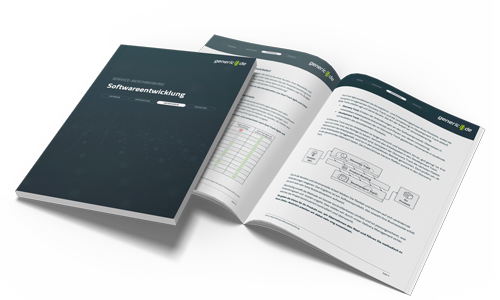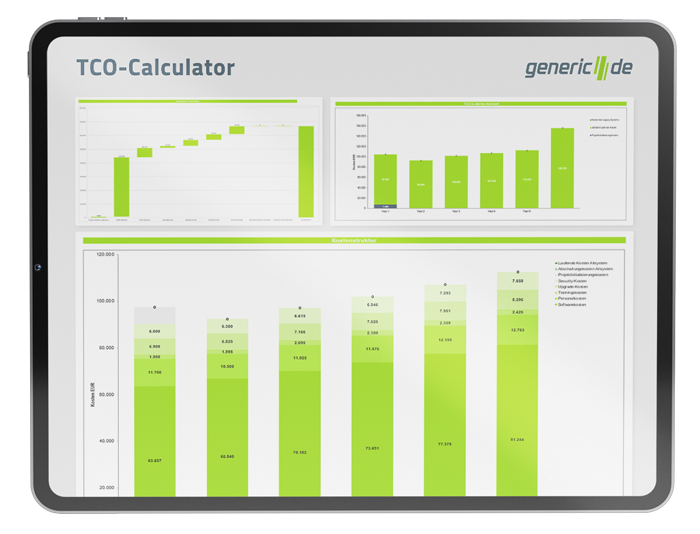We make your software project a success
Why generic.de
Because you get the perfectly adapted software solution
We design your solution individually — perfectly tailored to your business case, your users and your IT.
Because you get unlimited usage rights
The developed source code as well as the concepts and designs are always your property.
Because you have full cost and project control at all times
Thanks to our affiliated project management and regular reporting, you have full control over the project and budget at all times.
Developing the right thing right
Ideation

Results
Your benefits
Initial Discovery

Results
Your benefits
Dual Track Agile

scores
Your benefits
Operations & Support

Results
Your benefits
Selected case study
Book a discovery call for your software project
The most common questions regarding our software projects
When is custom software worthwhile
Individual software is worthwhile for companies when standard solutions do not precisely represent business processes or when strategically important competitive advantages are required. A tailor-made solution can be flexibly expanded, does not entail any license dependencies and — implemented correctly — ensures long-term investment security.
How does a software project work at generic.de?
generic.de works according to the principle Develop the right thing and divides every project into four phases: Invent (sharpen problem & vision), Explore (plan software concept, effort & costs), developing (implementation using the Dual Track Agile process) and Received (Operations & Support). Typical guidelines: 1—2 weeks of ideation, 2—12 weeks of concept, 6—12 months of implementation; subsequent operation is continuously scalable. This structure provides early cost transparency, rapid MVP results, and continuous improvements.
What exactly happens during the inventing/idea development phase?
In the “invent” phase, we identify business problems, prioritize ideas and formulate a reliable product vision — the basis for your software concept.
Together with our innovation partner Novazoon, we conduct methodologically based ideation workshops: In the Novazoon Innovation Lab, trends are analyzed via tech radar, prototypes are built and user feedback is obtained before the most promising use cases move on to concept development.
The added value: Outside-in perspective, TÜV-Süd-certified innovation methods and access to a 45-strong network of experts. The result is valid solutions that are seamlessly integrated into the subsequent software project and the agile development backlog — completely without vendor lock-in and with a clear budget preview.
What is a software concept and why is it decisive?
The software concept is developed during the “research” phase. It translates business goals, user needs, and technical frameworks into a prioritized product backlog, wireframes/UX prototypes, and a realistic roadmap. A solid concept reduces subsequent change costs, enables reliable cost estimates and forms the basis for investment decisions — a central element of successful custom software projects.
How does Dual Track Agile work and what added value does it bring to my software project?
Dual Track Agile combines two work streams: discovery (continuous idea validation with user testing) and delivery (incremental development). As a result, only features that have already been validated flow into programming; the team avoids bad investments and can implement user feedback close to the sprint. We use Dual Track Agile to shorten time-to-value and optimize UX & code at the same time.
What do you understand by clean code and why is it so important for my software project?
Clean Code has been at the center of every software development at generic.de since 2010. It includes clearly named classes & methods, low coupling, high test coverage and automated quality checks. As a result, your individual software remains permanently maintainable — changes cost less, bugs are identified early and the time-to-market is reduced. In the “Develop” development phase, clean code practices and concept work run in parallel in the Dual Track Agile process; this creates investment security and makes refactorings the exception rather than the rule.
In short: Clean Code reduces technical debt, lowers total operating costs and future-proof your software concept — a central quality anchor for every successful software project.
In addition, we offer in-house clean code training for your dev department, bringing over 15 years of practical experience directly to every customer project. You can find out more about this here: www.generic.de/services/clean-code training
How does generic.de ensure effective project management in my software project?
We combine classic project controlling — such as budget tracking and milestone reports — with Dual Track Agile: Discovery and delivery streams run in parallel, which means that planning and implementation are continuously coordinated. Our internal PMO creates weekly burn-down charts and financial reports so that clients always have full transparency about costs and progress.
Many competitors rely on so-called “agile fixed price models” to combine sprint flexibility with predictability — but often resort to rigid contract structures that quickly reach their limits when scope changes.
Our approach remains leaner: Through continuous delivery, automated monitoring and a clearly defined definition of done, individual software can be iteratively optimized — without hidden change requests and with clearly measurable time-to-value.
Who owns source code and usage rights at the end of the software project?
With generic.de, the client receives unrestricted, time-independent rights of use and exploitation of the complete source code — no vendor lock-in, full IP security. This distinguishes the approach of many agencies, which only grant simple usage rights. Legally, it is generally advisable to expressly record the transfer of rights in contracts; otherwise, in case of doubt, only a limited right of use applies (§ 69 UrhG).


